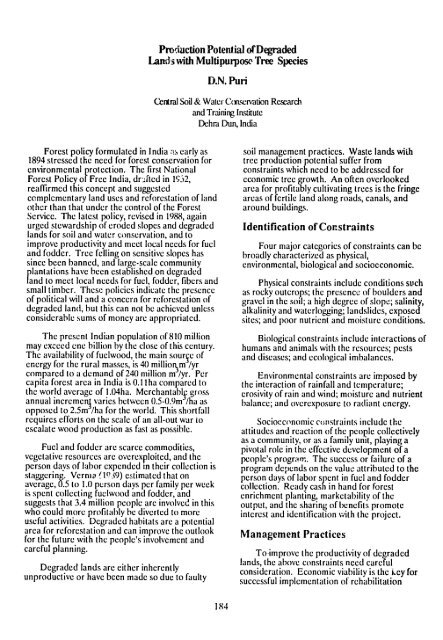multipurpose tree species research for small farms: strategies ... - part
multipurpose tree species research for small farms: strategies ... - part
multipurpose tree species research for small farms: strategies ... - part
You also want an ePaper? Increase the reach of your titles
YUMPU automatically turns print PDFs into web optimized ePapers that Google loves.
Forest policy <strong>for</strong>mulated in India u:, early as<br />
1894 stressed the need <strong>for</strong> <strong>for</strong>est conservation <strong>for</strong><br />
environmental protection. The first National<br />
Forest Policy of Free India, dri.fted in 1;%2,<br />
reaffirmed this concept and suggested<br />
cemplementary land uses and re<strong>for</strong>estation of land<br />
other than that under the control of the Forest<br />
Service. The latest policy, revised in 1988, again<br />
urged stewardship of eroded slopes and degraded<br />
lands <strong>for</strong> soil and water conservation, and to<br />
improve productivity and meet local needs <strong>for</strong> fuel<br />
and fodder. Tree felling on sensitive slopes has<br />
since been banned, and large-scale community<br />
plantations have been established on degraded<br />
land to meet local needs <strong>for</strong> fuel, fodder, fibers and<br />
<strong>small</strong> timber. These policies indicate the presence<br />
of political will and a concern <strong>for</strong> re<strong>for</strong>estation of<br />
degraded land, but this can not be achieved unless<br />
considerable sums of money are appropriated.<br />
The present Indian population of 810 million<br />
may exceed ene billion by the close of this century.<br />
The availability of fuelwood, the main sourie of<br />
energy <strong>for</strong> the rural masses, is 40 millior~m /yr<br />
compared to a demand of 240 million m /yr. Per<br />
capita <strong>for</strong>est area in India is 0.1 lha compared to<br />
the world average of 1.04ha. Merchantabl: gross<br />
annual incremenj varies between 0.5-0.9m /ha as<br />
opposed to 2.5m /ha <strong>for</strong> the world. This shortfall<br />
requires ef<strong>for</strong>ts on the scale of an all-out war to<br />
escalate wood production as fast as possible.<br />
Fuel and fodder are scarce commodities,<br />
vegetative resources are overexploited, and the<br />
person days of labor expended in their collection is<br />
staggering. Verma (1-9) estimated that on<br />
average, 0.5 to 1.0 person days per family per week<br />
is spent collecting fuclwood and fodder, and<br />
suggests that 3.4 million people are involved in this<br />
who could more profitably be diverted to more<br />
useful activities. Degraded habitats are a potential<br />
area <strong>for</strong> re<strong>for</strong>estation and can improve the outlook<br />
<strong>for</strong> the future with the people's involvement and<br />
careful planning.<br />
Degraded lands are either inherently<br />
unproductive or have been made so due to faulty<br />
Proiuction Potential offDegraded<br />
Lands with Multipurpose Tree Species<br />
D.N. Puri<br />
Central Soil & Water Cxservation Research<br />
and Training Institute<br />
Dehra Dun, India<br />
184<br />
soil management practices. Waste lands wiih<br />
<strong>tree</strong> production potential suffer from<br />
constraints which need to be addressed <strong>for</strong><br />
economic <strong>tree</strong> growth. An often overlooked<br />
area <strong>for</strong> profitably cultivating <strong>tree</strong>s is the fringe<br />
areas of fertile land along roads, canals, and<br />
around buildings.<br />
Identification of Constraints<br />
Four major categories of constraints can be<br />
broadly characterized as physical,<br />
environmental, biological and socioeconomic.<br />
Physical constraints include conditions such<br />
as rocky outcrops; the presence of boulders and<br />
gravel in the soil; a high degree of slope; salinity,<br />
alkalinity and waterlogging; landslides, exposed<br />
sites; and poor nutrient and moisture conditions.<br />
Biological constraints include interactions of<br />
humans and animals with the resources; pests<br />
and diseases; and ecological imbalances.<br />
Environmental constraints are imposed by<br />
the interaction of rainfall and temperature;<br />
erosivity of rain and wind; moisture and nutrient<br />
balance; and overexposure to radiant energy.<br />
Sociocconomic crstraints include the<br />
attitudes and reaction of the people collectively<br />
as a community, or as a family unit, playing a<br />
pivotal role in the effective development of a<br />
people's program. The success or failure of a<br />
program depends on the value attributed to the<br />
person days of labor spent in fuel and fodder<br />
collection. Ready cash in hand <strong>for</strong> <strong>for</strong>est<br />
enrichment planting, marketability of the<br />
output, and the sharing of benefits promote<br />
interest and identification with the project.<br />
Management Practices<br />
To-improve the productivity of degraded<br />
lands, the above constraints need careful<br />
consideration. Economic viability is the key <strong>for</strong><br />
successful implementation of rehabilitation

















